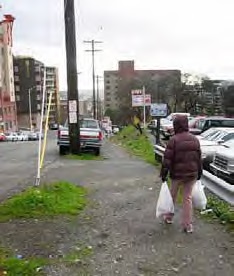Embracing Walking and Biking in State-Level Planning
Transportation agencies around the country work toward a well-balanced diet of travel options that are fully incorporated into transportation systems and available for all users. Safe lanes, paths, and other infrastructure for walking and bicycling can improve community health and reduce vehicle emissions.
To put walking and bicycling infrastructure in place, states bring together multidisciplinary teams in communities large and small to help bring life to innovative ideas for safely and seamlessly connecting motorized and nonmotorized transportation.
A Roadmap for Pedestrian and Bicycle Programs
While many local agencies focus on multimodal planning, a recent report by the Federal Highway Administration (FHWA) and Volpe also encourages leadership on pedestrian and bike planning at the state level. The Statewide Pedestrian and Bicycle Planning Handbook highlights several new and updated pedestrian and bike plans from around the country, and provides a foundation of goals, objectives, and performance measures for states that want to improve or create pedestrian and bike programs. This handbook is part of ongoing pedestrian and bike planning support that Volpe provides to FHWA.
“FHWA supports high-quality planning practices that boost the level of pedestrian and bicycle planning at the statewide and metropolitan planning organization levels,” said FHWA Office of Planning Director Kenneth Petty. “A number of people think of pedestrian and bicycle plans as a local issue. The idea behind this report is to highlight that it is also a state responsibility.”
The Statewide Pedestrian and Bicycle Planning Handbook is the most recent in a line of FHWA documents that encourage agencies at all levels to consider pedestrians and bicyclists in the transportation planning process. While there are several reviews of existing noteworthy pedestrian and bicycle planning efforts at the local level, few reviews highlight such efforts at the state level.
The Role of States
State roads provide a network that connects cities, towns, and rural areas. But state roads also go through downtown areas, where there may be vibrant pedestrian and bicycle activity. States have found that including pedestrian and bicycle needs through policy, partnering, and guidance encourages local areas to improve their pedestrian and bicycle planning.
Compared to local planning, statewide planning tends to take a wider view and focuses on not just specific transportation issues, but on broad themes and goals for making travel safe and efficient.


Before and after: A stretch of 6th Avenue South in Seattle was improved for pedestrians following a project that received state funding. (Washington Department of Transportation photo)
A Suite of Best Practices
In developing this new FHWA handbook, Volpe identified several key themes for states pursuing pedestrian and bicycle programs:
- Every plan needs a clear purpose.
- Every plan represents a particular point in time.
- Having several years of data on safety impacts and usage leads to informed decision making.
- Internal DOT coordination is important, particularly during the project development process.
- Public involvement can take time—but it is critical.
Public involvement is one of the highlights of the handbook. Volpe researchers found that making public involvement a significant piece of a pedestrian and bicycle plan improves planning outcomes.
Stay tuned for more on pedestrian and bicycle planning trends. FHWA and Volpe are working on a similar report that will explore best practices for pedestrian and bicycle planning at the metropolitan planning organization level.

